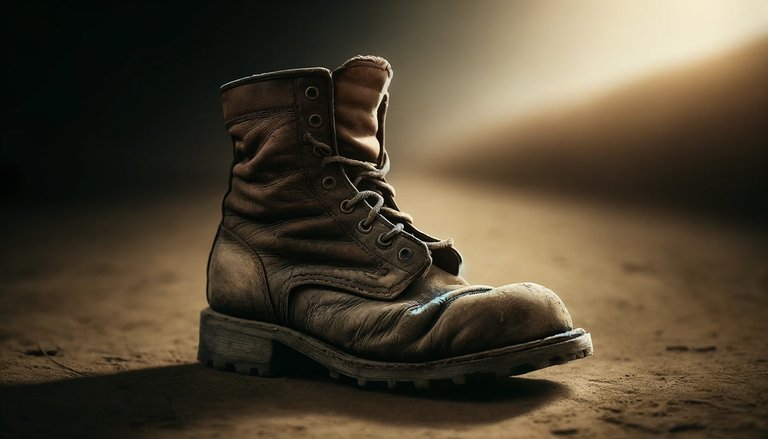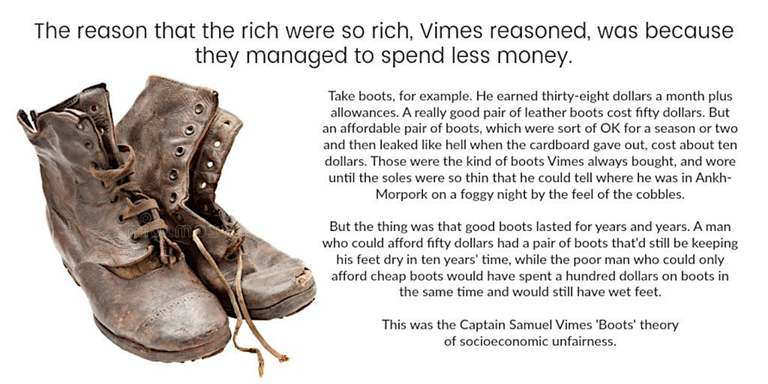The Boots Theory of Socioeconomic Unfairness

I think this counts as a reflection, making it a fit for this community. Let's cover some theory first, but scroll down for my own personal experiences and reflections about them.
I'm sure many of you have heard of this before. If you haven't, it expresses that poor people buy cheap products that need to be constantly replaced, because they are cheap, proving much more expensive in the long run than if they had been able to afford the expensive version of the product in the first place.
The idea is put forth as Sam Vimes' Books Theory of Socioeconomic Unfairness. It is from one of the books in the Discworld series by Terry Pratchett. He wrote:
“The reason that the rich were so rich, Vimes reasoned, was because they managed to spend less money.
Take boots, for example. He earned thirty-eight dollars a month plus allowances. A really good pair of leather boots cost fifty dollars. But an affordable pair of boots, which were sort of OK for a season or two and then leaked like hell when the cardboard gave out, cost about ten dollars. Those were the kind of boots Vimes always bought, and wore until the soles were so thin that he could tell where he was in Ankh-Morpork on a foggy night by the feel of the cobbles.
But the thing was that good boots lasted for years and years. A man who could afford fifty dollars had a pair of boots that'd still be keeping his feet dry in ten years' time, while the poor man who could only afford cheap boots would have spent a hundred dollars on boots in the same time and would still have wet feet.
This was the Captain Samuel Vimes 'Boots' theory of socioeconomic unfairness.”
I think we can all see some truth in this and can find examples in our own lives. I have two.
After I had been in Japan a few years, maybe around 18 years ago, I decided I was going to climb Mt Fuji. For this climb, I bought a pair of socks that was ¥12,000 at the time, which would have been about $120 at the time (actually probably closer to around $150. The yen was quite a bit higher than the dollar in those days, the opposite of today). Insane, right? I thought so too at the time, but I talked myself into it because they seemed to be really good quality and I wanted a smooth experience.
18 years later, I still have those socks, and they are still in good condition. I have worn them at least once a week since. Meanwhile if you add up all the money I have paid for cheaper socks over the years, cheaper socks that might last a year or two before they develop a hole in the heel or toes or the elastic gives out, I have paid well more than that ¥12000.
Another example is bags. Many people in Japan use backpacks. I'm no exception. When commuting by bicycle most of the time, a good backpack is really essential. When I first arrived here I would go through about a backpack a month. I'd buy one at the cheap store for ¥1000 (roughly $10) when I was at corporate for our monthly meeting, and then sometime over the next few weeks it'd develop holes or the zipper would stop working or something, and when the next corporate meeting rolled around the next month, I'd need one again.
I must have gone through 3 or 4 bags like this when I decided I needed to buy a higher quality bag. So I went to the North face store and bought one that was ¥15000—about $150 at the time. Again, that price seemed insane to me at the time. But... I still have that bag. It has finally developed a hole so I may have to replace it soon. But 20+ years of daily use for only $150... that's pretty good! Imagine how much I would have spent in that time if I had continued buying cheap bags.

These days ¥100 stores are really popular. Think of them as dollar stores. Cheap stuff from China. I think the ¥100 stores are probably cleaner and better organized than any dollar store in the States, but that's neither here nor there. The point is, it's full of cheap stuff: cheap both in price and also in quality. Stuff that falls apart very soon. But people have the idea that it's only ¥100 so who cares if it falls apart soon. They don't do the math to see that that ¥100 adds up, maybe to quite a lot.
I can think of another example:
I used to buy gel pens. The Signo RT. Really an amazing pen, pretty well balanced with dark, well saturated archive quality permanent ink. The Japanese are stationery fanatics and everything you find in the stationery area is high quality. But anyway, I loved the Signo RT. It was ¥100 and refills were ¥74 yen (roughly $1 and 74 cents at the time). I wrote a lot in my daily life for my various jobs and probably went through a refill a week. That's $4 a week, $48 a year, $192 in four years.
These days I use a fountain pen. The pen I use, a Pilot 823, cost me around ¥20,000 at the time (about $200). That seems like a lot, but I've been using it for more than 4 years, putting be past the point where disposable pens were cheaper.

Anyway, if you want to remember the Boots Theory, here is a handy gif:

❦
 |
David LaSpina is an American photographer and translator lost in Japan, trying to capture the beauty of this country one photo at a time and searching for the perfect haiku. He blogs here and at laspina.org. Write him on Twitter or Mastodon. |
Agree! I also have that observation with mountain biking. Need to prefer quality over quantity. Great article as always 👍 !PGM
👏 Keep Up the good work on Hive ♦️ 👏
❤️ @bhattg suggested sagarkothari88 to upvote your post ❤️
🙏 Don't forget to Support Back 🙏
I think the text offers a compelling perspective on how investing in quality products can be a smart strategy, even if it requires a higher initial expense. Your personal experiences with the shoes and backpack clearly highlight how the durability and superior quality of these items can result in significant long-term savings.
Personally, I believe it's important to consider not only the immediate price of a product but also its value over time. Sometimes, paying a bit more for something that lasts longer can save money in the long run and provide a more satisfying experience.
However, I recognize that not everyone has the financial capability to make these higher initial investments. This underscores the underlying economic inequalities that can prevent some people from accessing quality products, perpetuating cycles of unnecessary spending and hindering the building of financial stability.
Overall, I believe the text offers an important reflection on economic and social issues, and highlights the importance of considering long-term value when making purchasing decisions.
You need to think about "time value of money", then that boot theory would be tested and revised. Not saying it's right or wrong, but it's a good addition point of view.
In Spain they say cheap is expensive... Buy quality that lasts and it saves a lot of money! I agree with you one hundred percent!
!BBH
@dbooster! Your Content Is Awesome so I just sent 1 $BBH (Bitcoin Backed Hive) to your account on behalf of @thebighigg. (18/50)
I have the same experience with t-shirts! My mother bought me one on my birthday, more then 14 years ago, from a quality brand "Guess". Well, I still have it, and it still maintains the shape and the red color... Price pays the quality! And I don't exchange that for ten t-shirts from Primark or Zara